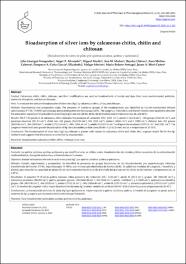Mostrar el registro sencillo del ítem
“Bioadsorption of silver ions by calcareous chitin, chitin and chitosan“
| dc.contributor.author | Jáuregui-Nongrados, John | |
| dc.contributor.author | Alvarado, Angel T. | |
| dc.contributor.author | Mucha, Miguel | |
| dc.contributor.author | Muñoz, Ana M. | |
| dc.contributor.author | Chávez, Haydee | |
| dc.contributor.author | Molina-Cabrera, Aura | |
| dc.contributor.author | Cuba-García, Pompeyo A. | |
| dc.contributor.author | Melgar-Merino, Elizabeth J. | |
| dc.contributor.author | Bolarte-Arteaga, Mario | |
| dc.contributor.author | Mori-Castro, Jaime A. | |
| dc.date.accessioned | 2023-05-24T15:31:21Z | |
| dc.date.available | 2023-05-24T15:31:21Z | |
| dc.date.issued | 2023-01-02 | |
| dc.identifier.uri | https://hdl.handle.net/20.500.13053/8619 | |
| dc.description.abstract | “Context: Calcareous chitin, chitin, chitosan, and their modifications are used as bioadsorbents of metals and dyes that cause environmental pollution, endocrine disruption, and human diseases. Aims: To evaluate the selective bioadsorption of silver ions (Ag+ ) by calcareous chitin, chitin, and chitosan. Methods: Experimental and prospective study. The presence of functional groups of the bioadsorbents was identified by Fourier-transformed infrared spectroscopy (FT-IR), 1H-NMR spectroscopy and scanning electron microscopy (SEM). The Langmuir, Freundlich, and Elovich models were applied to describe the adsorption capacity of bioadsorbents according to granule size (20-40, 40-60, 60-80 meshes) and temperature (10, 20, and 30°C). Results: The FT-IR spectrum of calcareous chitin indicates the presence of carbonate (CO3 = 1420 cm-1 ), amide III (1313 cm-1 ), –OH groups (3441.90 cm-1 ), and pyranose structure (952.83 cm-1 ); chitin has –OH groups (3441.90 cm-1 ), NH (3268 cm-1 ), amide I (1654 cm-1 ) and II (1559 cm-1 ); chitosan has –OH groups (3419.90 cm-1 ), –NH (3200 cm-1 ), amide I (1712.18 cm-1 ), –NH2 (1654.46 cm-1 ), amide III (1317.11 cm-1 ) and pyranose structure (1070.12 cm-1 and 1031 cm-1 ). The Langmuir model indicates greater bioadsorption of Ag+ ions at smaller particle sizes (60-80 = 0.25-0.18 mm) and at a temperature of 20-30°C. Conclusions: The bioadsorption of silver ions (Ag+ ) by chitosan is greater with respect to calcareous chitin and chitin; the Langmuir model fits for the Ag+ isotherm and suggests that the process is controlled by physisorption. “ | es_PE |
| dc.format | application/pdf | es_PE |
| dc.language.iso | eng | es_PE |
| dc.publisher | Academic Association of Pharmaceutical Sciences from Antofagasta (ASOCIFA) | es_PE |
| dc.rights | info:eu-repo/semantics/openAccess | es_PE |
| dc.rights.uri | https://creativecommons.org/licenses/by/4.0/ | es_PE |
| dc.subject | Academic Association of Pharmaceutical Sciences from Antofagasta (ASOCIFA) | es_PE |
| dc.title | “Bioadsorption of silver ions by calcareous chitin, chitin and chitosan“ | es_PE |
| dc.type | info:eu-repo/semantics/article | es_PE |
| dc.identifier.doi | https://doi.org/10.56499/jppres22.1529_11.1.101 | |
| dc.type.version | info:eu-repo/semantics/publishedVersion | es_PE |
| dc.publisher.country | CL | es_PE |
| dc.subject.ocde | 3.00.00 -- Ciencias médicas, Ciencias de la salud | es_PE |
Ficheros en el ítem
Este ítem aparece en la(s) siguiente(s) colección(es)
-
SCOPUS [380]


